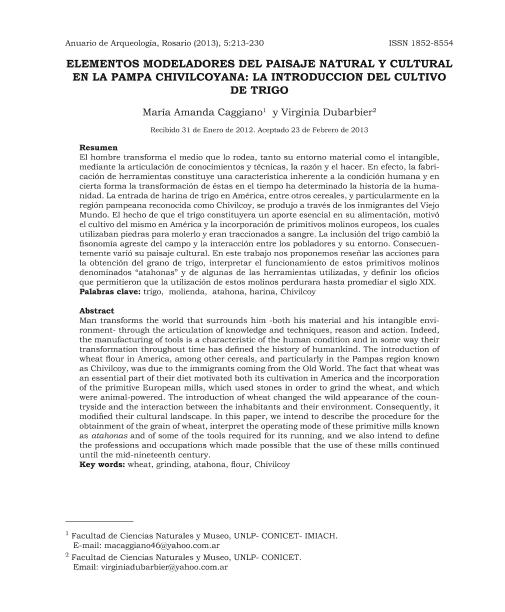Mostrar el registro sencillo del ítem
dc.contributor.author
Caggiano, Maria Amanda

dc.contributor.author
Dubarbier, Virginia

dc.date.available
2017-03-08T20:02:26Z
dc.date.issued
2013-09
dc.identifier.citation
Caggiano, Maria Amanda; Dubarbier, Virginia; Elementos modeladores del paisaje natural y cultural en la Pampa Chivilcoyana: la introduccion del cultivo de trigo; Universidad de Rosario. Facultad de Humanidades y Artes. Escuela de Antropologia; Anuario de Arqueología; 5; 9-2013; 213-230
dc.identifier.issn
1852-8554
dc.identifier.uri
http://hdl.handle.net/11336/13651
dc.description.abstract
El hombre transforma el medio que lo rodea, tanto su entorno material como el intangible, mediante la articulación de conocimientos y técnicas, la razón y el hacer. En efecto, la fabricación de herramientas constituye una característica inherente a la condición humana y en cierta forma la transformación de éstas en el tiempo ha determinado la historia de la humanidad. La entrada de harina de trigo en América, entre otros cereales, y particularmente en la región pampeana reconocida como Chivilcoy, se produjo a través de los inmigrantes del Viejo Mundo. El hecho de que el trigo constituyera un aporte esencial en su alimentación, motivó el cultivo del mismo en América y la incorporación de primitivos molinos europeos, los cuales utilizaban piedras para molerlo y eran traccionados a sangre. La inclusión del trigo cambió la fisonomía agreste del campo y la interacción entre los pobladores y su entorno. Consecuentemente varió su paisaje cultural. En este trabajo nos proponemos reseñar las acciones para la obtención del grano de trigo, interpretar el funcionamiento de estos primitivos molinos denominados “atahonas” y de algunas de las herramientas utilizadas, y definir los oficios que permitieron que la utilización de estos molinos perdurara hasta promediar el siglo XIX.
dc.description.abstract
Man transforms the world that surrounds him -both his material and his intangible environment- through the articulation of knowledge and techniques, reason and action. Indeed, the manufacturing of tools is a characteristic of the human condition and in some way their transformation throughout time has defined the history of humankind. The introduction of wheat flour in America, among other cereals, and particularly in the Pampas region known as Chivilcoy, was due to the immigrants coming from the Old World. The fact that wheat was an essential part of their diet motivated both its cultivation in America and the incorporation of the primitive European mills, which used stones in order to grind the wheat, and which were animal-powered. The introduction of wheat changed the wild appearance of the countryside and the interaction between the inhabitants and their environment. Consequently, it modified their cultural landscape. In this paper, we intend to describe the procedure for the obtainment of the grain of wheat, interpret the operating mode of these primitive mills known as atahonas and of some of the tools required for its running, and we also intend to define the professions and occupations which made possible that the use of these mills continued until the mid-nineteenth century.
dc.format
application/pdf
dc.language.iso
spa
dc.publisher
Universidad de Rosario. Facultad de Humanidades y Artes. Escuela de Antropologia
dc.rights
info:eu-repo/semantics/openAccess
dc.rights.uri
https://creativecommons.org/licenses/by-nc-sa/2.5/ar/
dc.subject
Trigo
dc.subject
Molienda
dc.subject
Atahona
dc.subject
Chivilcoy
dc.subject
Harina
dc.subject.classification
Otras Historia y Arqueología

dc.subject.classification
Historia y Arqueología

dc.subject.classification
HUMANIDADES

dc.title
Elementos modeladores del paisaje natural y cultural en la Pampa Chivilcoyana: la introduccion del cultivo de trigo
dc.type
info:eu-repo/semantics/article
dc.type
info:ar-repo/semantics/artículo
dc.type
info:eu-repo/semantics/publishedVersion
dc.date.updated
2017-03-06T14:07:45Z
dc.journal.number
5
dc.journal.pagination
213-230
dc.journal.pais
Argentina

dc.journal.ciudad
Rosario
dc.description.fil
Fil: Caggiano, Maria Amanda. Universidad Nacional de La Plata. Facultad de Ciencias Naturales y Museo; Argentina. Consejo Nacional de Investigaciones Científicas y Técnicas; Argentina. Instituto Municipal de Investigaciones Antropológicas de Chivilcoy; Argentina
dc.description.fil
Fil: Dubarbier, Virginia. Universidad Nacional de La Plata. Facultad de Ciencias Naturales y Museo; Argentina. Consejo Nacional de Investigaciones Científicas y Técnicas; Argentina
dc.journal.title
Anuario de Arqueología
dc.relation.alternativeid
info:eu-repo/semantics/altIdentifier/url/http://rephip.unr.edu.ar/handle/2133/5068
Archivos asociados
